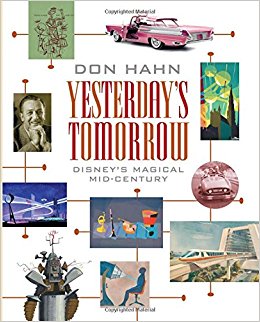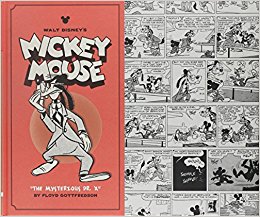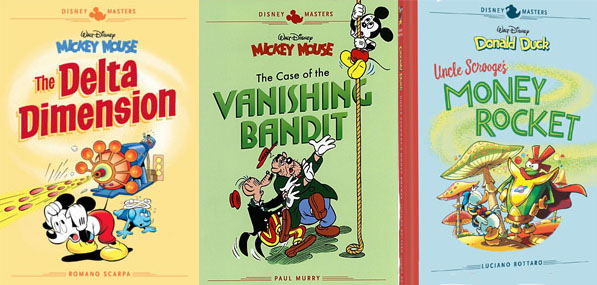Yesterday’s Tomorrow: Disney’s Magical Mid-Century By Don Hahn (Disney Editions).
 Producer Don Hahn (Beauty and The Beast, The Lion King, etc.) is on a roll in recent years with a series of Disney history tomes and documentaries. All great, all recommended. His latest book is particularly of interest to me, as I love this period of Disney “magic”.
Producer Don Hahn (Beauty and The Beast, The Lion King, etc.) is on a roll in recent years with a series of Disney history tomes and documentaries. All great, all recommended. His latest book is particularly of interest to me, as I love this period of Disney “magic”.
Yesterday’s Tomorrow examines Disney’s take on UPA stylized design, the post-war era and Walt Disney’s part in shaping the decade of the 1950s and early 60s. This includes the creation of Disneyland and Cal Arts, Disney’s television shows, commercials, and music. The text discusses about how progressive the studios (and Walt’s) thinking was – at a time that is now considered the height of conformist “normalcy”. The oversized book is lavishly illustrated with the coolest stylized images of Disney art, Disney and photographs that immerse you in the era – what we call today “retro-future”.
This is another of several recent books that shatter the myths about Walt Disney – who is essentially know for Snow White, Bambi and Cinderella, but completely overlooked for the pioneering work he and his studio did to further the culture, and educate the public, with incredible art that was of its time – and, I dare say, ahead of it.
Walt Disney’s Mickey Mouse Vol. 12: “The Mysterious Dr. X” Edited by David Gerstein and Gary Groth (Fantagraphics)
 The prolific David Gerstein (and co-editor Gray Groth) concludes a masterful series of volumes reprinting the Floyd Gottfredson years on the daily Mickey Mouse newspaper comic strip. The 12th volume covers the 1953-1955 continuities (after which the strip went strictly ‘gag-a-day’).
The prolific David Gerstein (and co-editor Gray Groth) concludes a masterful series of volumes reprinting the Floyd Gottfredson years on the daily Mickey Mouse newspaper comic strip. The 12th volume covers the 1953-1955 continuities (after which the strip went strictly ‘gag-a-day’).
Coincidentally, this book makes a great companion to Don Hahn’s book (reviewed above). The 1950s stories find a post-war suburban Mickey who harbors a juvenile delinquent; befriends a troublesome old Uncle Grudger; and becomes a trench-coated detective in search of ‘The Mysterious Dr. X’ (spoiler alert: its Goofy). Six years before Disney released Darby O’Gill and The Little People, our Mickey takes off for Ireland and encounters the mischievous King of The Little People (or “Little Folk”); the mouse becomes a Monkey’s “uncle” when his uncle Maxwell leaves him a sophisticated gorilla companion (named “Umbrage”); he takes a “Journey To The Center of the Earth” with a way-out subterranean character named Wing Ding; and then there is the whole “L’il Davy and Jiminy Crockett” segments that reflect the biggest Disney fad of the decade better than any other spin-off can.
As usual, Gerstein finds more unusual odds and ends to illustrate the “bonus material” and essays that precede and follow the comics goldmine at the center. Once again Thomas Andre writes a foreword that puts the strips in context of the times they were created. Mickey cartoonist Jonathan H. Gray pens a respectful appreciation; Gerstein writes about Gottfredson’s attempt to put Mickey’s neglected personality (after 1955) into a new comic strip of his own: “Mark O’Polo”; and much more addendum and errata… this entire library is essential to anyone studying comic art or Disney history. I can’t recommend these volumes highly enough.
Totally Awesome: The Greatest Cartoons of the Eighties by Andrew Farago (Insight)
 It’s inevitable that as we get older, the nostalgia for years past catches up with us. Let’s be clear, the 1980s was NOT the greatest decade in the history of animation, especially for TV animation, but if you worked in it or grew up watching it there were some joys to be had. Artists began to break free of the stifling cookie-cutter straight jacket the industry had become. The kids at home had a huge choice on their TV menu – classic cartoons from the 1940s and 50s, the last of the Filmation/DiC/Hanna Barbara factory product, and beginning of the cartoon renaissance that fully emerged in the 1990s.
It’s inevitable that as we get older, the nostalgia for years past catches up with us. Let’s be clear, the 1980s was NOT the greatest decade in the history of animation, especially for TV animation, but if you worked in it or grew up watching it there were some joys to be had. Artists began to break free of the stifling cookie-cutter straight jacket the industry had become. The kids at home had a huge choice on their TV menu – classic cartoons from the 1940s and 50s, the last of the Filmation/DiC/Hanna Barbara factory product, and beginning of the cartoon renaissance that fully emerged in the 1990s.
Andrew Farago, curator of San Francisco’s Cartoon Art Museum, has assembled a wonderful overview of the most remembered (and I suppose somewhat “significant”) cartoon series from that decade. Broken into fourteen chapters, Farago has tracked down key creatives on each show to explain the appeal and decision making that went into these works. It’s hard to argue with the choices of series to showcase in this book – whether you like them or hate them, they do represent the decade: The Smurfs, He-Man and She-Ra, G.I. Joe, The Transformers, Inspector Gadget, Jim, Thundercats, Muppet Babies, Teenage Mutant Ninja Turtles, Garfield – all these shows are signatures the 1980s.
Lavishly illustrated with color cels, model sheets and storyboards, author Farago talks with the writers, artists and voices (including Russi Taylor who provides a Forward) – all of whom are justly proud at their efforts despite the low budgets and rushed production schedules. The final two chapters are on Garfield and Bakshi’s Mighty Mouse: The New Adventures, the quality of these shows foreshadow the higher quality boom coming in the next decade. Now that “Saturday Morning” is a thing of the past, this book and bowl of Cocoa Puffs cereal is all you really need to relive the eighties.
Lotte Reiniger: Pioneer of Film Animation by Whitney Grace (McFarland)
 I don’t think I ever realized that there wasn’t a full-length book about Lotte Reiniger until I received a copy of this new book by Whitney Grace. Surely this pioneering woman animator – the master of the silhouette film, and the first woman to make an animated feature (before Disney) in the silent era – has been documented before. There have been books about her films and her art – but this is a full scale biography of her life and her struggles to live the life of an artist .
I don’t think I ever realized that there wasn’t a full-length book about Lotte Reiniger until I received a copy of this new book by Whitney Grace. Surely this pioneering woman animator – the master of the silhouette film, and the first woman to make an animated feature (before Disney) in the silent era – has been documented before. There have been books about her films and her art – but this is a full scale biography of her life and her struggles to live the life of an artist .
Grace has done a lot a research and it shows. This isn’t a picture book – but there are many rare photos that illustrate the text perfectly. It’s a thorough story of a unique artists life – a woman who never thought she attained perfection, but we know she did through her animation, illustration and puppetry. Grace traces Reniger’s career (with her husband and partner Carl Koch) in the 1910s through the 80s in great detail – spending 40 pages alone on the making of Prince Achmed – how sound film in the early 30s and the rise of the Nazi’s in the latter 30s affected her work. She survived the death of her husband in the 1960s and turned to fine art. The book covers it all. Appendices include a Lotte Reniger filmography and bibliography. Recommended.
The Animated Marx Brothers by Matthew Hahn (Bear Manor)
 Marx Brothers fans love just about anything the comedy troupe ever did – even bits of film they didn’t do. Matthew Hahn has created the complete – and I mean complete – guide to the Marx Brothers in animation.
Marx Brothers fans love just about anything the comedy troupe ever did – even bits of film they didn’t do. Matthew Hahn has created the complete – and I mean complete – guide to the Marx Brothers in animation.
The look of the three (sometimes four) brothers were so outlandish, they were ripe for caricature. Their zany humor felt right at home in cartoons. Their stardom at the dawn of the talkie era made them instantly recognizable to the public – and it was a quick, easy laugh for animators to add the Marx boys to any scene to liven up the proceedings. Hahn, a huge Marx fan had to know how many cartoons they appear in – together or separately, and he has done his homework.
The first 60 pages detail the theatrical cartoons – Disney’s The Bird Store (1932) is apparently the Marx’s first animated cameo… and before you know it every studio in Hollywood, New Rochelle and Manhattan, goes Marx crazy. “Television Marxtoons” is the second chapter and that begins with a 1960 Quick Draw McGraw cartoon (“Scooter Rabbit”) and goes all the way to a 2015 Spongebob episode! Everything!
Did you know there were two Marx Brothers cartoon pilots (one by Filmation in 1966; another in 2000 produced by Gary Kurtz, with Frank Ferrante as Groucho)? Later chapters document “Animated Effects and Credits in Marx Brother Movies”, “Marxtoons in You Bet Your Life, Groucho and the DeSoto Commercials” and a chapter on Marx animation that didn’t fit in the other chapters (like the Vlassic Pickle commercials). “Marxtoon Trivia”, “Where To Buy Marxtoons” a bibliography, footnotes and an index fill the 195 pages – and Joe Adamson was the obvious choice to pen a Foreword. Perfect! A nifty piece of research – I enjoyed it!
SHOUT OUTS and SHORT TAKES

Disney Masters Vols. 1-3 is the start of a new series by Fantagraphics books reprinting in hardcover some of the best Disney comics by the finest practitioners of the craft. The Delta Dimension from Italy’s Romano Scarpa, is published in English for the first time – a zany adventure sending Mickey in to a another universe with a way-out new friend, Atomo Bleep-Bleep! Uncle Scrooge’s Money Rocket by Luciano Bottaro is my favorite of the initial trio, with three crazy stories featuring Donald Duck, Gyro Gearloose, the nephews, Witch Hazel and of course Uncle Scrooge – this one features some of the wildest artwork I’ve ever seen! American Mickey master Paul Murry is featured in The Case of the Vanishing Bandit the title of one of the seven stories reprinted here, originally done for Dell’s (Western Publishing) Mickey Mouse comic books. Murry’s work is the blandest of the artists represented here – but he was a mainstay and his art has become part of Mickey’s legacy. The material here might be his best work.
Disney Masters Vol. 1: Romano Scarpa: Walt Disney’s Mickey Mouse: The Delta Dimension
Disney Masters Vol. 2: Luciano Bottaro: Walt Disney’s Donald Duck: Uncle Scrooge’s Money Rocket
Disney Masters Vol. 3: Paul Murry: Walt Disney’s Mickey Mouse: The Case Of The Vanishing Bandit


 Jerry Beck is a writer, animation producer, college professor and author of more than 15 books on animation history. He is a former studio exec with Nickelodeon Movies and Disney, and has written for The Hollywood Reporter and Variety. He has curated cartoons for DVD and Blu-ray compilations and has lent his expertise to dozens of bonus documentaries and audio commentaries on such. Beck is currently on the faculty of CalArts in Valencia, UCLA in Westwood and Woodbury University in Burbank – teaching animation history. More about Jerry Beck [
Jerry Beck is a writer, animation producer, college professor and author of more than 15 books on animation history. He is a former studio exec with Nickelodeon Movies and Disney, and has written for The Hollywood Reporter and Variety. He has curated cartoons for DVD and Blu-ray compilations and has lent his expertise to dozens of bonus documentaries and audio commentaries on such. Beck is currently on the faculty of CalArts in Valencia, UCLA in Westwood and Woodbury University in Burbank – teaching animation history. More about Jerry Beck [



































Now that the Popeye reprint series is no longer being published by IDW, my new favorite animation-related comic book is Rocko’s Modern Life by Boom! Studios. It’s very faithful to the original TV series, while injecting a bit of a “downbeat” tone to the stories that help give them a feeling of relatability amidst all the typical craziness. The artwork has a tendency to get overblown and hard to follow every once in a while, but is well done overall. And, like the Simpsons and SpongeBob comic books, there is a story in each book illustrated in a different cartoonist’s “style”. Recommended.
It may have been only a footnote to American 1980s TV animation, and it was only arguably produced in America, but is Harmony Gold’s 1985 series “Robotech” mentioned at all in “Totally Awesome: The Greatest Cartoons of the Eighties”?
The 1980s were the decade that “anime”, Japanese theatrical and TV animation, first became established in America. Building upon imports of the late 1970s from Japan like “Battle of the Planets” and “Star Blazers”, Harmony Gold and its producer/director Carl Macek made the 85-episode “Robotech” in 1985 from three different TV series by Japan’s Tatsunoko Productions. “Robotech”, and Macek’s and Jerry Beck’s Streamline Pictures in 1988, were instrumental in launching the popularity of “anime” in the U.S. and Canada.
oh, i just can NOT wait to buy the Marxes. I’m sure he will have included “Animaniacs”….which, as we all know, is based on nothing BUT that style of humor!!! Thanky!!
Yup, ANIMANIACS is in there!
I’ve not seen it in person, but “Lotte Reiniger: Born with Enchanting Hands” by Evamarie Blattner was published in English back in 2010. But at only 112 pages, it may be more general in scope.
I have been enjoying the Floyd Gottfredson books, especially the later volumes that reprint material that Gladstone comics never got around to. It is an interesting way to see how Gottfredson and the writers adapted Mickey to the times, from a living a rural life to living in post-war suburbia. The two Disney Masters Mickey Mouse volumes make nice companion pieces to the Gottfredson Library. Both Paul Murry and Romano Scarpa kept sending Mickey out on adventures long after the newspaper strips went to a gag-a-day format, with very different approaches to their work. Scarpa’s strips served as a continuation of Gottfredson’s work in Italy, where Murry’s work served up simpler mysteries squarely aimed at younger readers.
Interesting to know that only now the North American public will know the work of Romano Scarpa … Here in Brazil, Disney comics have great popularity, especially those produced by Italian artists. For those unfamiliar with Romano Scarpa, I can simply say that he was the first artist to draw Disney comics in Italy. And he is considered the Grand Master, who inspired dozens of other artists in that country, including his most famous disciple, Giorgio Cavazzano.
Well, in fact, Romano Scarpa is one of the few Italian Disney comics artists who IS known to a certain degree in North America. He had the honor of being the first Italian artist to be published in an American Disney comic book, way back in 1988… and many more publications followed. So it feels like a natural to start off such a book series with a volume dedicated to Scarpa. 🙂 Especially when said volume includes two never-before-published stories right from his golden age.
Thanks, Jerry!
“The Delta Dimension from Italy’s Romano Scarpa, is published in English for the first time – a zany adventure sending Mickey in to a another universe with a way-out new friend, Atomo Bleep-Bleep!”
Actually, the title story in the “Delta Dimension” book HAS been publised in English before — in a digest-size paperback from Gemstone back in 2006. It’s the only one of the book’s three stories which has been seen in the States before, though. (And it feels natural to include it since it introduces Atomo Bleep-Bleep, who co-stars with Mickey in all three of the tales.) I’m looking forward to picking up the Scarpa book myself… and the Bottaro one seems interesting too.
The Marx Brothers book is Excellent.